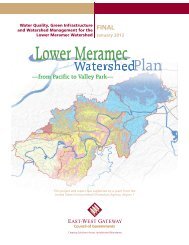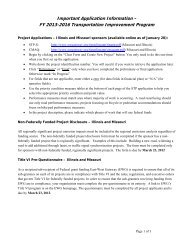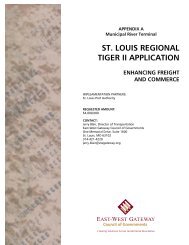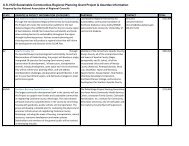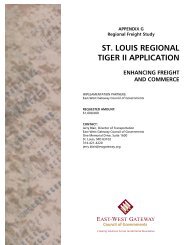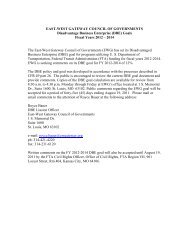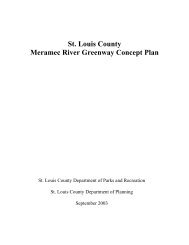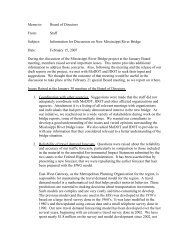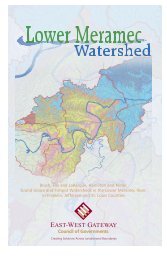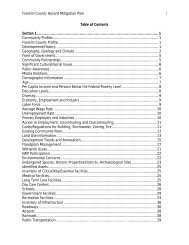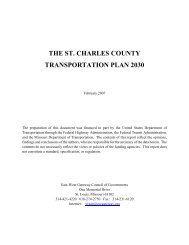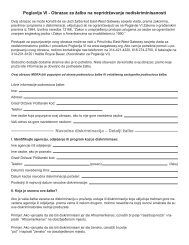Jefferson County - East-West Gateway Coordinating Council
Jefferson County - East-West Gateway Coordinating Council
Jefferson County - East-West Gateway Coordinating Council
You also want an ePaper? Increase the reach of your titles
YUMPU automatically turns print PDFs into web optimized ePapers that Google loves.
140<br />
HAZARD ANALYSIS NARRATIVE<br />
Hazard: Severe Winter Weather<br />
<strong>Jefferson</strong> <strong>County</strong> – Section 2<br />
Description of Hazard (Type of hazard, pathways/areas likely affected, type of damage,<br />
etc.) Severe winter weather is defined as sleet, freezing rain, and heavy snow. This can be<br />
accompanied by strong winds creating blizzard conditions, severe drifting and dangerous<br />
wind chill. Ice storms cause significant hazards as well. Communications and power can be<br />
disrupted for days, resulting in residents using alternate fuel sources that are likely to start<br />
fires. Strong winds with intense storms and cold fronts knock down trees, utility poles,<br />
power lines. Extreme cold often accompanies a winter storm in its wake. Winter weather<br />
can result in injuries, death, and property damage. Prolonged exposure to cold can cause<br />
frostbite, hypothermia can become life-threatening. The average pathway may vary in any<br />
direction, but the average winter storm moves from west to east. Winter storms are most<br />
likely to occur in November through February but may ensue from October through April.<br />
Any person or structure at any location could be damaged by a winter storm.<br />
Historical Statistics (Frequency, strength, # of lives lost, # of injuries, economic losses,<br />
etc.) Economic losses are difficult to measure. Local governments, home and business<br />
owners can be faced with spending millions of dollars for snow removal, restoration of<br />
services, debris removal and landfill hauling. NOAA weather indicates that the Missouri<br />
counties north of the Missouri River receive an average snowfall of 18-22 inches, and<br />
counties south of the river receive an average of 8-12 inches. Historical statistics for the<br />
EWGCC include the winter storm in January 1994 that resulted in temperatures dropping to<br />
–20 F degrees below zero, with wind chills to –50 degrees F below zero. In January 1977,<br />
the EWGCC region received the maximum snowfall for the area at 23.9 inches of snow with<br />
temperatures hovering around –14 degrees F below zero. Also in January 1982, the<br />
EWGCC region received a 24 maximum snowfall of 13.9 inches with temperatures around –<br />
15 degrees F below zero. In February 1914, the EWGCC received the maximum snowfall for<br />
the area for this month at 23.5 inches of snow. In December 1973, the EWGCC region<br />
received its maximum snowfall for the area for this month at 26.3 inches. The coldest<br />
December on record was 1983 with temperature average of 20.5 degrees F. Multiple<br />
homes and businesses had water pipes break, people were admitted to hospitals for<br />
hypothermia/frostbite and schools were closed.<br />
Statement of Future Probable Severity (Catastrophic/Critical/Limited/Negligible). Ice<br />
storms could be limited to catastrophic<br />
Statement of Probable Risk (Likeliness of future occurrence-(Highly<br />
Likely/Likely/Possible/Unlikely) Winter/ice storms are likely to occur in the future.<br />
Statement of Next Disaster’s Likely Adverse Impact on the Community<br />
(Catastrophic/Critical/Limited/Negligible)<br />
Without Mitigation Measures: Life Property Emotional Financial



